Impact of El Niño Southern Oscillation on Rainfall and Rice Production: A Micro-Level Analysis
Abstract
1. Introduction
2. Data and Methodology
2.1. ENSO Identification
2.2. Classification of ENSO Events
2.3. Rainfall Data
2.4. Rice Production Data
2.5. Analysis
3. Results
3.1. The Percent Change in Seasonal and Annual Rainfall during El Niño Years
3.2. The Percent Change in Seasonal and Annual Rainfall during La Niña Years
3.3. Impact of ENSO Events on the Rainfall of Karnataka State (1951–2014)
3.4. Impact of ENSO Events on Area, Production, and Productivity of Kharif Rice
4. Discussion
4.1. Impact of ENSO Events on the Rainfall of Karnataka State
4.2. Impact of ENSO Events on Area, Production, and Productivity of Kharif Rice
4.3. Relationship between Seasonal Rainfall and Kharif Rice Production
5. Conclusions
Author Contributions
Funding
Institutional Review Board Statement
Informed Consent Statement
Data Availability Statement
Acknowledgments
Conflicts of Interest
References
- Anonymous. Ministry of Statistics and Programme Implementation Government of India. Available online: http://statisticstimes.com/economy/country/india-gdp-sectorwise.php (accessed on 12 March 2021).
- Sekhara, K. Trends in area, production and productivity of paddy crop: An overview. Int. J. Humanit. Soc. Sci. Invent. 2019, 8, 50–58. [Google Scholar]
- Anonymous. Ministry of Agriculture and Farmers Welfare, Government of India. Available online: https://www.indiastat.com (accessed on 28 February 2020).
- Selvaraju, R. Impact of El Niño-Southern Oscillation on Indian foodgrain production. Int. J. Climatol. 2003, 23, 187–206. [Google Scholar] [CrossRef]
- Iizumi, T.; Luo, J.J.; Challinor, A.J.; Sakurai, G.; Yokozawa, M.; Sakuma, H.; Brown, M.E.; Yamagata, T. Impacts of El Niño Southern Oscillation on the global yields of major crops. Nat. Commun. 2014, 15, 3712. [Google Scholar] [CrossRef]
- Webster, P.J.; Magana, V.O.; Palmer, T.N.; Shukla, J.; Thomas, R.A.; Yanai, M.; Yasunari, T. Monsoons: Processes, predictability and the prospects of prediction. J. Geophys. Res. 1998, 103, 14451–14510. [Google Scholar] [CrossRef]
- Prasanna, V. Impact of monsoon rainfall on the total food grain yield over India. J. Earth. Syst. Sci. 2014, 123, 1129–1145. [Google Scholar] [CrossRef]
- Webster, P.J.; Yang, S. Monsoon and ENSO: Selectivity Interactive Systems. Q. J. R. Meteorol. Soc. 1992, 118, 877–926. [Google Scholar] [CrossRef]
- Prasad, R.; Rao, V.U.M.; Rao, B.B. Res Bull No. 01. In El Niño—Its Impact on Rainfall and Crop Productivity—A Case Study for Himachal Pradesh; CSK HPKV: Palampur, India, 2014; pp. 1–24. [Google Scholar]
- Krishnamurthy, V.; Goswami, B.N. Indian Monsoon–ENSO Relationship on Interdecadal Timescale. J. Clim. 2000, 13, 579–595. [Google Scholar] [CrossRef]
- Pai, D.S. Teleconnections of Indian summer monsoon with global surface air temperature anomalies. Mausam 2003, 54, 407–418. [Google Scholar]
- Kane, R.P. Unstable ENSO Relationship with Indian regional rainfall. Int. J. Climatol. 2005, 26, 771–783. [Google Scholar] [CrossRef]
- Kumar, K.K.; Rajagopalan, B.; Cane, M.A. On the weakening relationship between the Indian Monsoon and ENSO. Science 1999, 284, 2156–2159. [Google Scholar] [CrossRef] [PubMed]
- Shukla, J.; Mooley, D.A. Empirical prediction of the summer monsoon rainfall over India. Mon. Weather Rev. 1987, 115, 695–703. [Google Scholar] [CrossRef]
- Gregory, S. Macro-regional definition and characteristics of Indian summer monsoon rainfall. Int. J. Climatol. 1989, 9, 465–483. [Google Scholar] [CrossRef]
- Null, J. El Niño and La Niña Intensities. Available online: http://ggweather.com/enso/oni.htm (accessed on 12 March 2021).
- Conover, W.J. Practical Non-Parametric Statistics; Wiley: New York, NY, USA, 1971. [Google Scholar]
- Mooley, D.A.; Parthasarathy, B. Indian Summer Monsoon and the East Equatorial Pacific Sea Surface Temperature. Atmos. Ocean 1984, 22, 23–35. [Google Scholar] [CrossRef][Green Version]
- Mooley, D.A.; Parthasarathy, B. Indian summer monsoon and El Niño. Pure Appl. Geophys. PAGEOPH 1983, 121, 339–352. [Google Scholar] [CrossRef]
- Kripalani, R.H.; Kulkarni, A. Assessing the Impacts of El Niño and Non-El Niño-related Droughts over India. Drought Netw. News (1994–2001) 1996, 24. Available online: https://digitalcommons.unl.edu/droughtnetnews/24 (accessed on 12 March 2021).
- Subash, N.; Gangwar, B. Statistical analysis of Indian rainfall and rice productivity anomalies over the last decades. Int. J. Clim. 2014, 34, 2378–2392. [Google Scholar] [CrossRef]
- Victor, U.S.; Srivastava, N.N.; Subba Rao, A.V.M.; Ramana Rao, B.V. El Niño’s Effect on Southwest Monsoon Rainfall in Andhra Pradesh, India. Drought Netw. News (1994–2001) 1995, 89. Available online: https://digitalcommons.unl.edu/droughtnetnews/89 (accessed on 12 March 2021).
- Zubair, L.; Ropelewski, C.F. The Strengthening Relationship between ENSO and Northeast Monsoon Rainfall over Sri Lanka and Southern India. J. Clim. 2006, 19, 1567–1575. [Google Scholar] [CrossRef]
- De, U.S.; Mukhopadhyay, R.K. The effect of ENSO/Anti ENSO on northeast monsoon rainfall. Mausam 1999, 50, 343–354. [Google Scholar]
- Ropelewski, C.F.; Halpert, M.S. Global and regional scale precipitation patterns associated with the El-Niño Southern Oscillation. Mon. Weather Rev. 1987, 115, 1606–1626. [Google Scholar] [CrossRef]
- Rajeevan, M.; Unnikrishnan, C.K.; Bhate, J.; Kumara, K.N.; Sreekalab, P.P. Northeast monsoon over India: Variability and prediction. Meteorol. Appl. 2012, 19, 226–236. [Google Scholar] [CrossRef]
- Patel, H.R.; Lunagaria, M.M.; Pandey, V.; Rao, B.B.; Rao, V.U.M.; Sharma, P.K. Tech Bull No. 01. In El Niño Episodes and Agricultural Productivity in Gujarat; Anand Agric Univ Anand: Anand, India, 2014; pp. 1–22. [Google Scholar]
- Rao, V.U.M.; Subba Rao, A.V.M.; Rao, B.B.; Ramana Rao, B.V.; Sravani, C.; Venkateswarlu, B. Res Bull No. 2. In El Niño Effect on Climatic Variability and Crop Production—A Case Study for Andhra Pradesh; CRIDA: Hyderabad, India, 2011; pp. 1–35. [Google Scholar]
- Manikandan, N.; Chaudhary, J.L.; Khavse, R.; Rao, V.U.M. El-niño impact on rainfall and food grain production in Chhattisgarh. J. Agrometeorol. 2016, 18, 142–145. [Google Scholar]
- Gadgil, S.; Gadgil, S. The Indian Monsoon, GDP and agriculture. Econ. Polit. Wkly. 2006, 41, 4887–4895. [Google Scholar]
- Hansen, J.W.; Jones, J.W.; Irmak, A.; Royce, F. El Niño-Southern Oscillation Impacts on Crop Production in the Southeast United States; ASA Special Publication: Madison, WI, USA, 2001. [Google Scholar]
- Phillips, J.G.; Cane, M.A.; Rosenzweig, C. ENSO, seasonal rainfall patterns and simulated maize yield variability in Zimbabwe. Agric. For. Meteorol. 1998, 90, 39–50. [Google Scholar] [CrossRef]
- Zubair, L. El Niño—Southern Oscillation influences on rice production in Sri Lanka. Int. J. Climatol. 2002, 22, 249–260. [Google Scholar] [CrossRef]
- Kiran, S.R. Impact of rainfall on rice production of India. Int. J. Innov. Res. Sci. Eng. Technol. 2016, 5, 258–265. [Google Scholar]


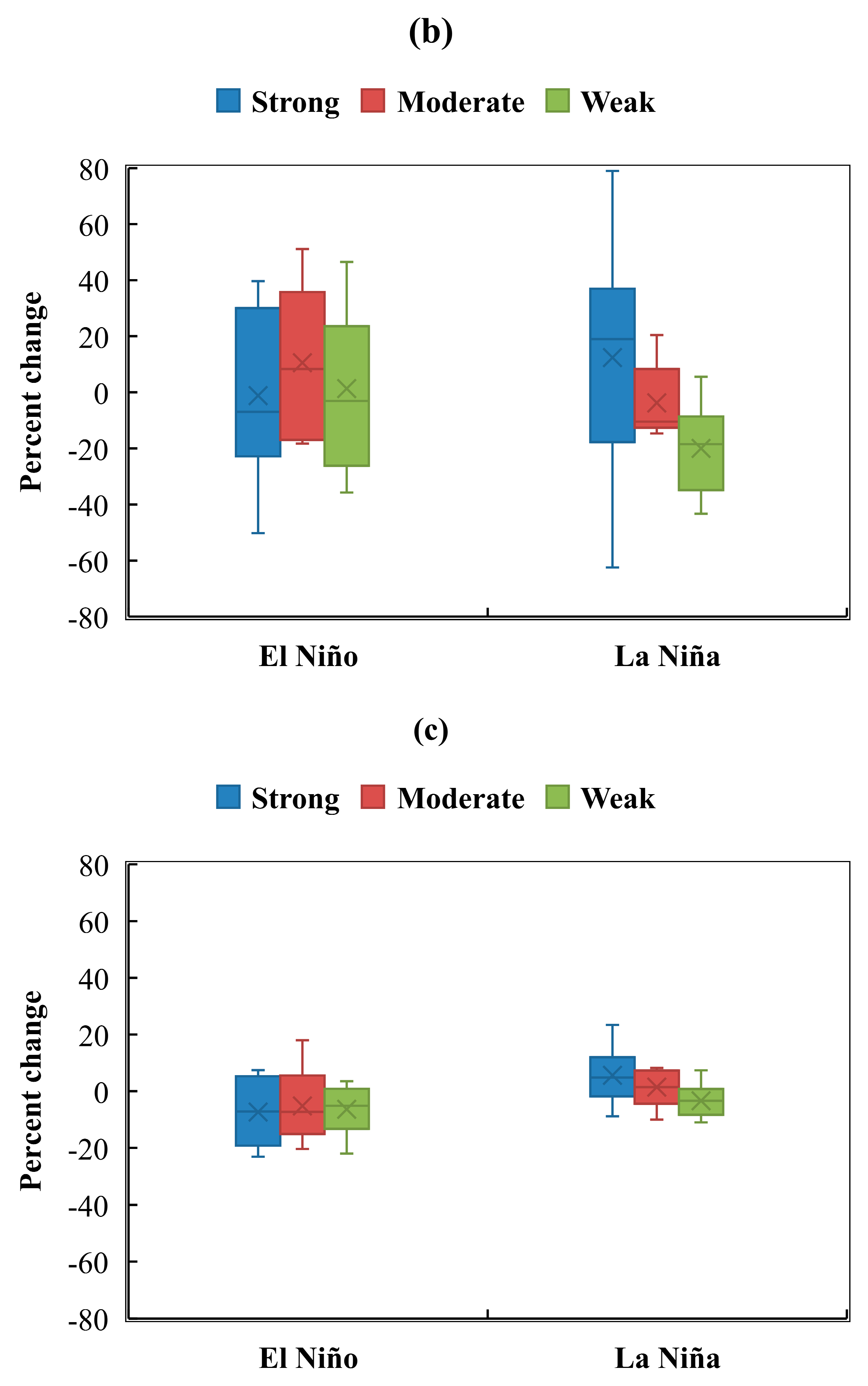
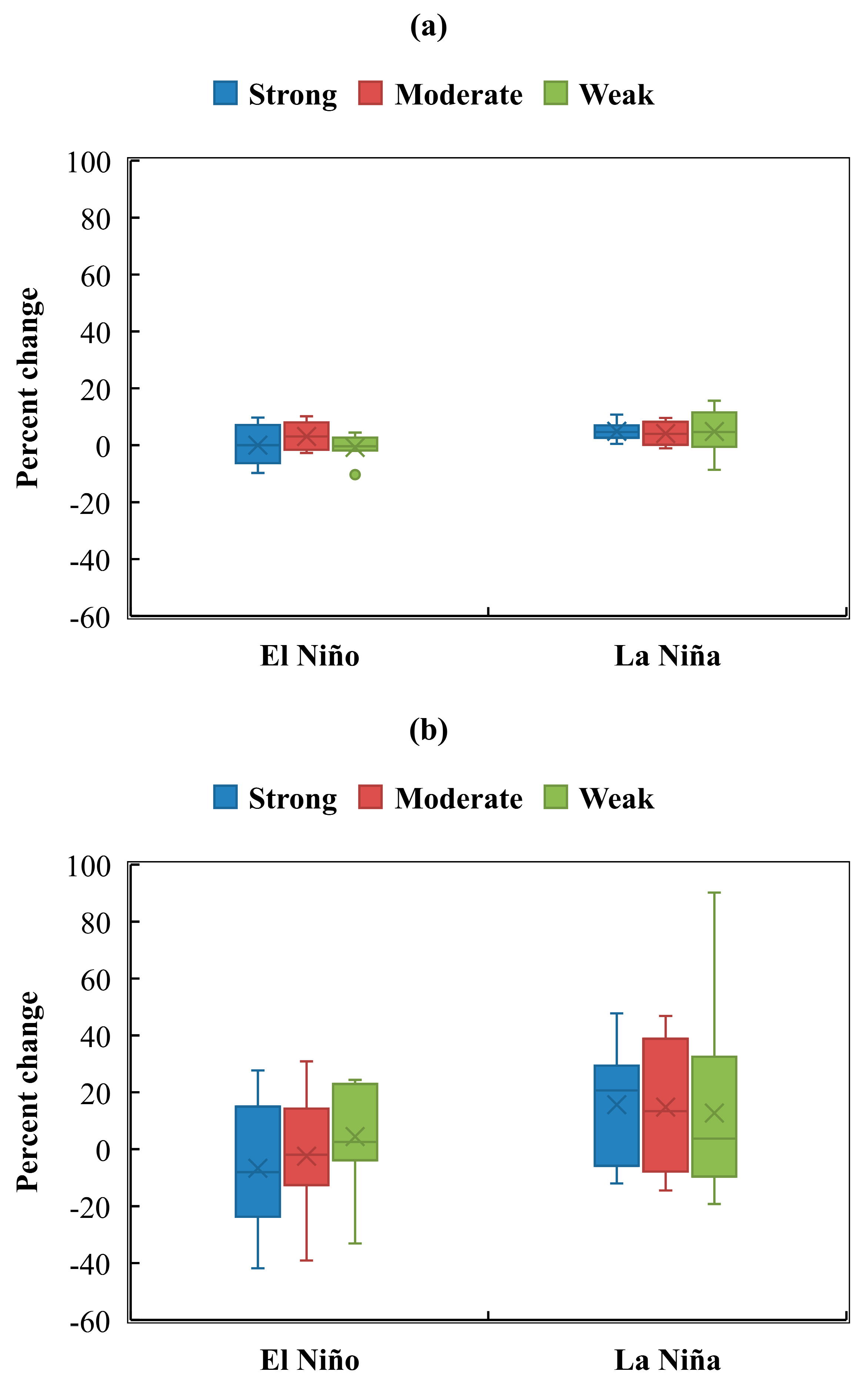
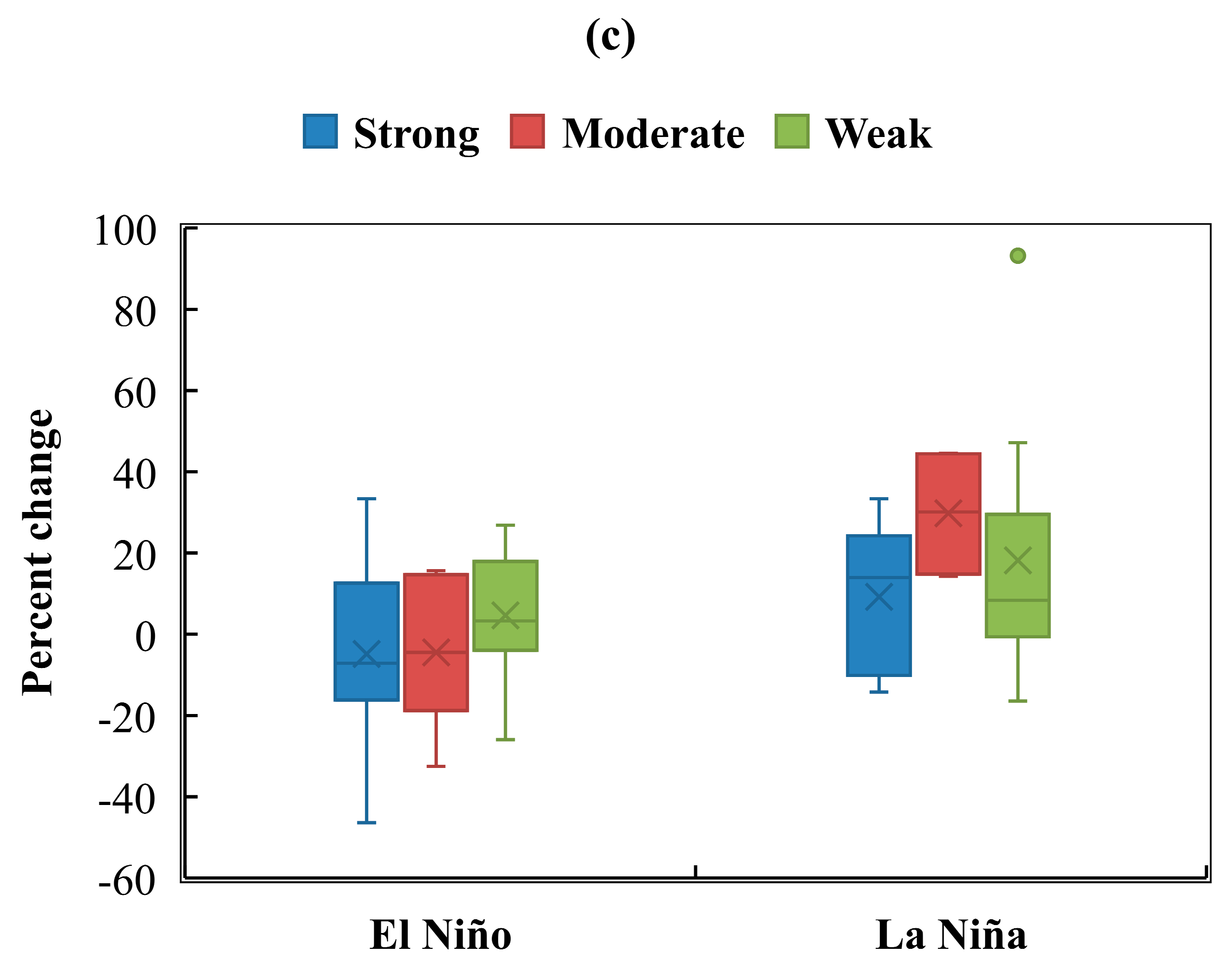
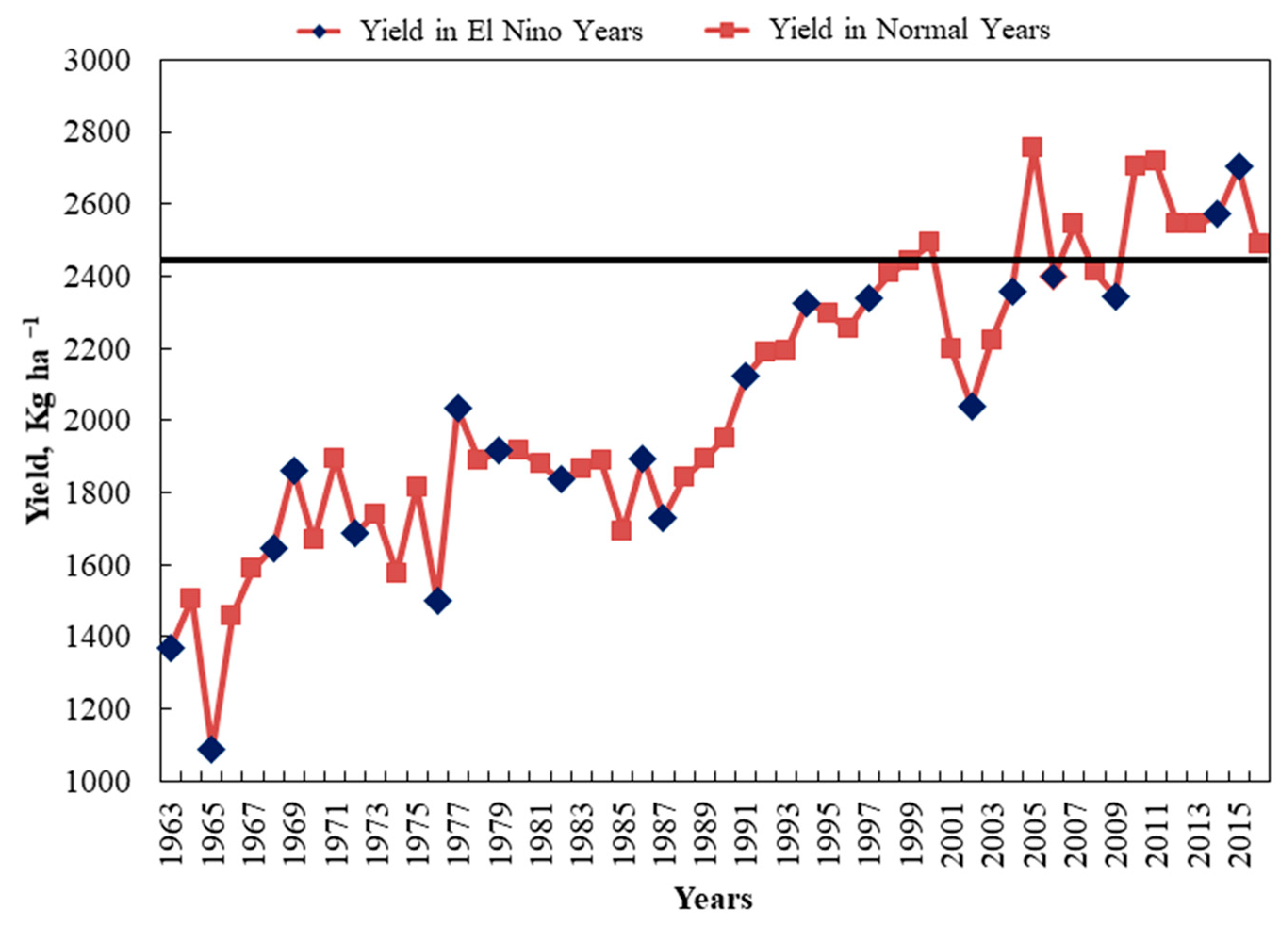

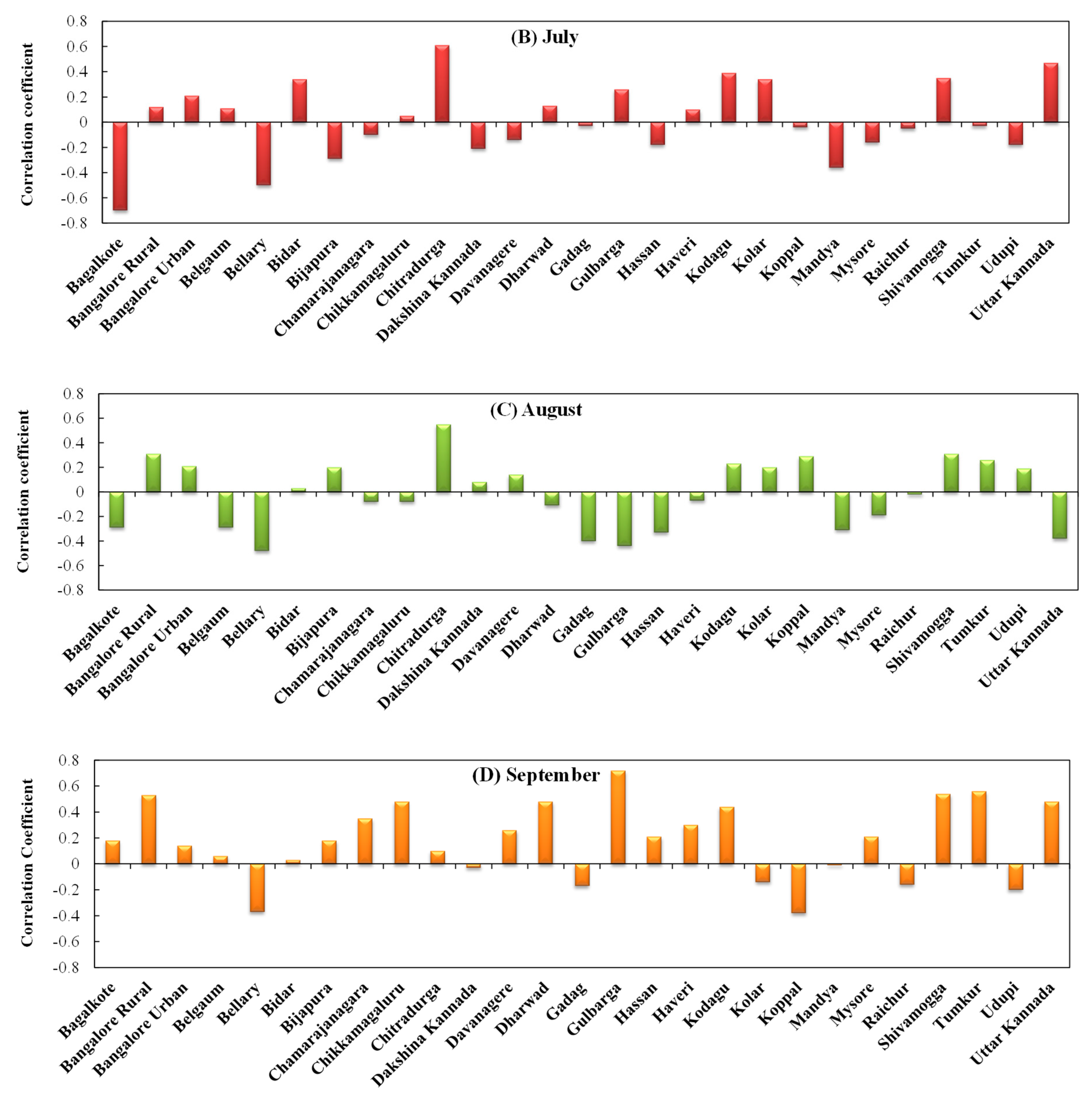
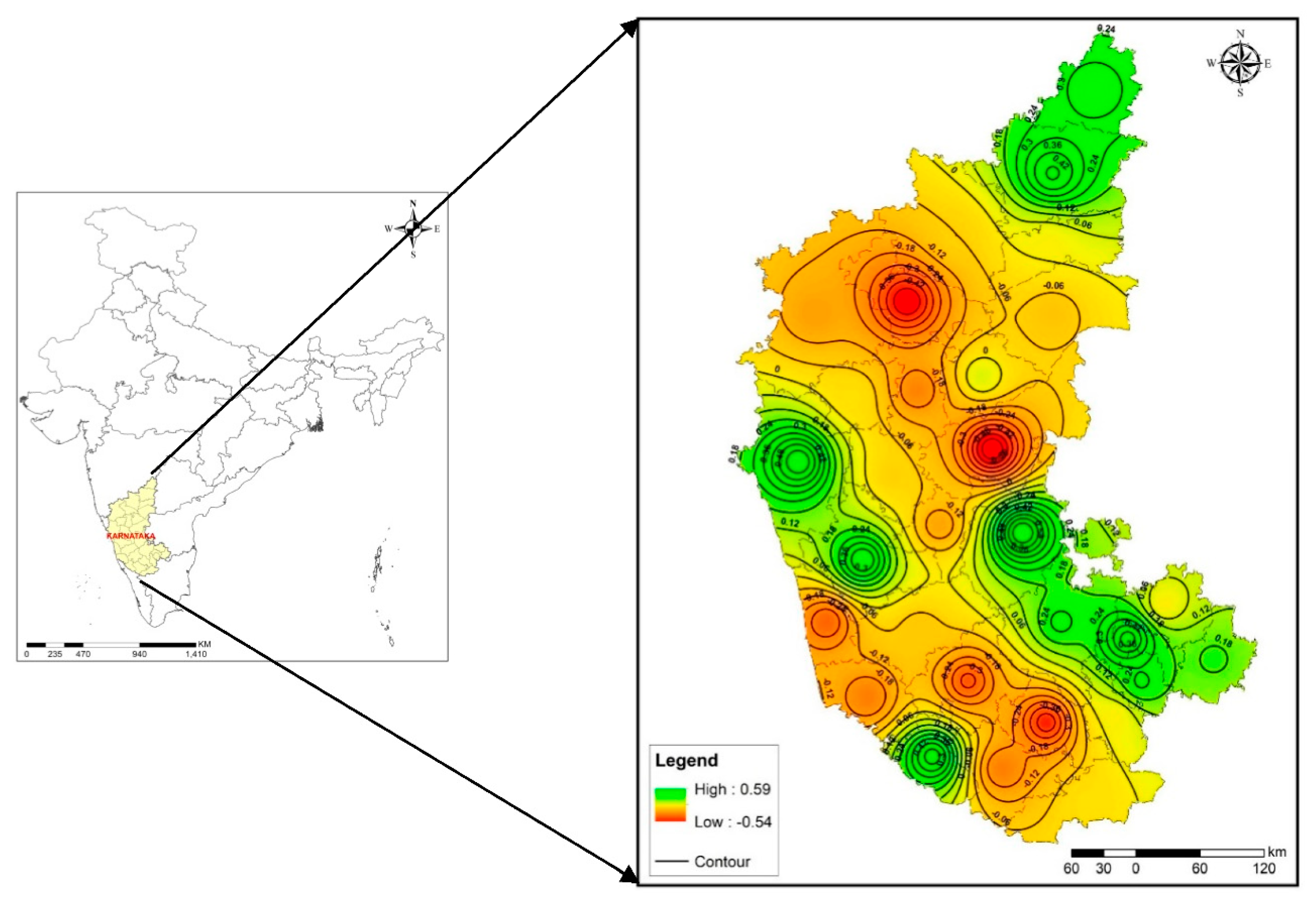
| El Niño Intensity | Years |
|---|---|
| Weak El Niño | 1952, 1953, 1958, 1969, 1976, 1977, 1979, 2004, 2006, 2014, 2018 |
| Moderate El Niño | 1951, 1963, 1968, 1986, 1994, 2002, 2009 |
| Strong El Niño | 1957, 1965, 1972, 1982, 1987, 1991, 1997, 2015 |
| Neutral years | 1950, 1956, 1959, 1960, 1961, 1962, 1966, 1967, 1978, 1980, 1981, 1985, 1989, 1990, 1992, 1993, 1996, 2001, 2003, 2012, 2013 |
| La Niña Intensity | Years |
|---|---|
| Weak La Niña | 1954, 1964, 1971, 1974, 1983, 1984, 2000, 2005, 2008, 2016, 2017 |
| Moderate La Niña | 1955, 1970, 1995, 2011 |
| Strong La Niña | 1973, 1975, 1988, 1998, 1999, 2007, 2010 |
| Neutral years | 1950, 1956, 1959, 1960, 1961, 1962, 1966, 1967, 1978, 1980, 1981, 1985, 1989, 1990, 1992, 1993, 1996, 2001, 2003, 2012, 2013 |
| Strong El Niño | Moderate El Niño | Weak El Niño | |||||||
|---|---|---|---|---|---|---|---|---|---|
| Districts | SWM | NEM | A | SWM | NEM | A | SWM | NE | A |
| Udupi | −13.47 | −13.55 | −14.49 | −2.05 | 10.79 | −3.66 | −10.09 | −2.41 | −9.94 |
| Dakshina Kannada | −8.90 | −2.47 | −10.19 | −8.64 | 8.05 | −8.37 | −11.78 | −3.55 | −10.38 |
| Uttara Kannada | −13.41 | −20.86 | −15.12 | −11.07 | 7.81 | −11.14 | −8.51 | −17.84 | −9.06 |
| Coastal Karnataka | −11.93 | −12.29 | −13.27 | −7.25 | 8.88 | −7.72 | −10.13 | −7.93 | −9.79 |
| Bagalkote | −7.69 | −4.50 | −8.54 | 0.23 | 14.91 | 0.35 | −13.75 | −16.51 | −12.48 |
| Belgaum | −10.94 | −5.53 | −8.69 | −8.76 | 15.74 | −7.34 | −8.60 | −7.61 | −8.51 |
| Bellary | −9.14 | −3.36 | −6.85 | −7.13 | 15.57 | −6.00 | −10.46 | −7.84 | −9.83 |
| Bidar | −14.87 | −16.45 | −13.09 | −12.66 | −6.06 | −10.24 | −10.08 | −30.06 | −9.42 |
| Bijapura | −12.05 | −7.56 | −12.35 | 0.94 | 22.24 | 2.83 | −10.59 | −13.23 | −8.08 |
| Gadag | −5.46 | −9.45 | −5.00 | −5.28 | 12.13 | −2.24 | −14.92 | −10.18 | −10.63 |
| Gulbarga | −15.59 | −17.48 | −14.16 | −6.96 | 23.83 | −1.26 | −8.58 | −18.27 | −5.04 |
| Koppal | −8.13 | −0.55 | −5.86 | 5.01 | 14.19 | 6.18 | −19.91 | −18.02 | −14.89 |
| Dharwad | −7.61 | −3.13 | −7.01 | −8.03 | 13.72 | −6.82 | −15.12 | −7.62 | −13.11 |
| Haveri | −7.89 | −2.17 | −8.79 | −7.04 | 7.65 | −7.31 | −19.35 | −6.39 | −16.90 |
| Raichur | −13.32 | −16.02 | −13.39 | 0.58 | 64.65 | 16.23 | −16.79 | −28.06 | −13.87 |
| North Interior Karnataka | −10.24 | −7.84 | −9.43 | −4.46 | 18.05 | −1.42 | −13.47 | −14.89 | −11.16 |
| Kolar | −19.89 | 15.47 | −5.29 | −12.41 | −20.18 | −13.23 | −15.35 | −1.42 | −7.67 |
| Mandya | −12.09 | −0.14 | −7.99 | −13.84 | −11.53 | −12.18 | −26.47 | −0.98 | −15.81 |
| Mysore | −14.88 | 4.04 | −10.44 | −17.72 | −6.50 | −14.90 | −31.69 | −8.97 | −24.04 |
| Tumkur | −13.80 | 11.50 | −5.01 | −8.55 | −17.49 | −9.03 | −15.47 | 5.94 | −4.95 |
| Bangalore Rural | −14.52 | 11.55 | −1.16 | −2.94 | −21.08 | −7.79 | −5.07 | 9.53 | 4.88 |
| Bangalore Urban | −12.00 | 11.70 | 1.51 | 3.17 | −18.40 | −2.66 | −1.19 | 4.26 | 6.91 |
| Chamarajanagara | −16.73 | 17.32 | −4.28 | −16.78 | −11.47 | −12.27 | −22.66 | −1.73 | −10.27 |
| Chitradurga | −9.36 | 3.15 | −5.32 | −3.96 | −7.50 | −4.43 | −12.45 | −2.11 | −5.69 |
| Davanagere | −8.40 | −1.80 | −7.71 | −7.85 | 0.06 | −6.25 | −17.56 | −5.23 | −13.48 |
| South Interior Karnataka | −13.52 | 8.09 | −5.08 | −8.99 | −12.68 | −9.19 | −16.43 | −0.08 | −7.79 |
| Shivamogga | −12.57 | −6.56 | −12.28 | −7.65 | 2.46 | −7.17 | −0.89 | −7.64 | −2.40 |
| Chikkamagaluru | −13.16 | −3.56 | −10.76 | −11.65 | −4.32 | −9.40 | 0.03 | −4.24 | 0.69 |
| Kodagu | −15.11 | 1.07 | −12.24 | −9.76 | 3.56 | −8.09 | 4.92 | −0.46 | 8.07 |
| Hassan | −14.02 | −3.41 | −11.55 | −16.98 | −11.51 | −15.18 | −22.37 | −7.13 | −17.73 |
| Malnad Region | −13.72 | −3.12 | −11.71 | −11.51 | −2.45 | −9.96 | −4.58 | −4.87 | −2.84 |
| Strong La Niña | Moderate La Niña | Weak La Niña | |||||||
|---|---|---|---|---|---|---|---|---|---|
| Districts | SWM | NEM | A | SWM | NEM | A | SWM | NEM | A |
| Udupi | 6.56 | 16.34 | 5.19 | 1.81 | −15.09 | −0.78 | −8.49 | −24.90 | −11.11 |
| Dakshina Kannada | 5.78 | 14.90 | 4.93 | 6.99 | −10.53 | 6.11 | −4.85 | −27.69 | −7.41 |
| Uttara Kannada | 2.30 | −0.42 | 0.28 | −4.54 | 2.40 | −3.96 | −7.84 | −26.64 | −10.37 |
| Coastal Karnataka | 4.88 | 10.28 | 3.47 | 1.42 | −7.74 | 0.46 | −7.06 | −26.41 | −9.63 |
| Bagalkote | 13.92 | 6.10 | 3.38 | −8.08 | 2.14 | −4.10 | 1.49 | −19.85 | −6.34 |
| Belgaum | −7.72 | 3.65 | −9.49 | −15.43 | 26.64 | −10.23 | −14.88 | −20.00 | −15.51 |
| Bellary | −6.07 | 3.50 | −8.18 | −19.59 | 18.45 | −13.80 | −15.00 | −20.24 | −15.56 |
| Bidar | 16.57 | 12.68 | 11.49 | 29.72 | −27.84 | 18.02 | 13.49 | −12.01 | 6.55 |
| Bijapura | 15.12 | 13.76 | 5.72 | 1.51 | −9.22 | −2.44 | 5.05 | −17.82 | −4.18 |
| Gadag | −1.57 | −8.62 | −5.64 | −23.86 | −11.07 | −16.34 | −12.30 | −27.14 | −13.99 |
| Gulbarga | 12.81 | 12.38 | 7.73 | 20.93 | −2.23 | 13.99 | 11.98 | −16.31 | 4.12 |
| Koppal | 20.31 | −1.83 | 9.83 | −7.76 | −14.79 | −0.72 | 5.71 | −25.53 | −3.58 |
| Dharwad | −11.07 | −7.51 | −12.89 | −21.43 | 9.41 | −14.77 | −18.39 | −21.55 | −18.17 |
| Haveri | 4.57 | 0.58 | 0.24 | −14.69 | −3.13 | −7.78 | −14.32 | −24.17 | −15.68 |
| Raichur | 21.12 | −3.84 | 7.72 | 9.87 | −6.20 | 9.24 | 12.05 | −19.22 | 0.84 |
| North Interior Karnataka | 7.09 | 2.81 | 0.90 | −4.44 | −1.62 | −2.63 | −2.28 | −20.35 | −7.41 |
| Kolar | 18.74 | 4.11 | 14.28 | −6.55 | −1.08 | 1.26 | 13.02 | 1.64 | 7.45 |
| Mandya | 9.10 | −4.67 | 7.04 | −27.44 | 17.18 | −13.33 | −5.31 | −13.37 | −5.97 |
| Mysore | −3.05 | −9.31 | −3.12 | −32.66 | 5.28 | −21.25 | −17.89 | −14.19 | −15.80 |
| Tumkur | 16.52 | −0.54 | 12.09 | −20.50 | 7.16 | −4.91 | 1.81 | −12.87 | −2.01 |
| Bangalore Rural | 25.72 | 3.19 | 16.37 | −1.21 | 1.53 | 7.20 | 20.39 | −1.47 | 10.73 |
| Bangalore Urban | 30.49 | 2.07 | 20.47 | 2.25 | −7.19 | 9.04 | 26.71 | 1.60 | 15.75 |
| Chamarajanagara | 7.92 | 1.22 | 7.59 | −26.45 | −13.02 | −12.67 | −16.16 | −4.48 | −9.31 |
| Chitradurga | 22.48 | 4.59 | 15.51 | −20.49 | −6.59 | −4.95 | 0.84 | −26.08 | −8.03 |
| Davanagere | 12.04 | 7.38 | 7.30 | −18.51 | −14.53 | −9.98 | −9.14 | −27.47 | −12.47 |
| South Interior Karnataka | 15.55 | 0.89 | 10.84 | −16.84 | −1.25 | −5.51 | 1.58 | −10.74 | −2.18 |
| Shivamogga | 6.47 | −4.88 | 2.71 | −14.93 | −6.95 | −9.58 | −4.17 | −30.94 | −7.40 |
| Chikkamagaluru | 7.07 | −10.51 | 4.09 | −27.13 | −14.07 | −20.88 | −4.09 | −33.64 | −7.35 |
| Kodagu | 17.48 | −4.17 | 12.56 | −11.10 | −2.27 | −5.90 | 4.04 | −13.62 | 1.30 |
| Hassan | −2.26 | −7.17 | −2.67 | −33.05 | 9.51 | −24.02 | −12.78 | −22.24 | −12.90 |
| Malnad Region | 7.19 | −6.68 | 4.18 | −21.55 | −3.45 | −15.09 | −4.25 | −25.11 | −6.59 |
| Strong and moderate La Niña | Weak La Niña | |||||
|---|---|---|---|---|---|---|
| Districts | Area | Production | Yield | Area | Production | Yield |
| Udupi | 5.40 | −5.98 | −10.25 | 3.38 | 0.69 | −2.39 |
| Dakshina Kannada | 7.20 | −1.25 | −7.37 | −1.43 | −0.83 | 1.44 |
| Uttara Kannada | 5.02 | 11.72 | 4.54 | 1.94 | 4.76 | 1.01 |
| Coastal Karnataka | 5.87 | 1.49 | −4.36 | 1.30 | 1.54 | 0.02 |
| Belgaum | 4.60 | 56.17 | 46.28 | 5.22 | 44.52 | 35.10 |
| Bellary | 2.06 | 1.38 | −2.07 | 6.71 | 2.92 | −4.47 |
| Bidar | 6.20 | 1.08 | −15.94 | −12.48 | −16.57 | −9.49 |
| Gadag | −4.29 | −4.41 | 1.42 | 18.38 | 51.49 | 20.59 |
| Gulbarga | 13.12 | 19.13 | −17.10 | 48.77 | 29.32 | 25.77 |
| Koppal | −0.44 | 5.42 | 5.13 | 0.10 | −2.47 | −2.81 |
| Dharwad | 5.71 | 23.58 | 15.52 | −1.67 | 15.15 | 10.53 |
| Haveri | 4.32 | 33.77 | 37.64 | −10.28 | 35.75 | 43.31 |
| Raichur | 0.58 | 3.30 | 4.39 | 8.17 | 20.02 | 11.82 |
| North Interior Karnataka | 3.54 | 15.49 | 8.36 | 6.99 | 20.02 | 14.48 |
| Kolar | 52.36 | 51.03 | −2.28 | 16.04 | 16.17 | −3.17 |
| Mandya | 15.36 | 21.44 | 5.44 | 11.23 | 1.68 | −9.63 |
| Mysore | 13.07 | 9.00 | −3.52 | 2.23 | −5.19 | −7.18 |
| Tumkur | 56.91 | 69.08 | 6.48 | 49.53 | 55.69 | 0.99 |
| Bangalore Rural | 32.84 | 47.86 | 7.19 | 44.78 | 45.01 | 6.40 |
| Bangalore Urban | 40.10 | 63.86 | 8.81 | 10.85 | 29.85 | 8.27 |
| Chamarajanagara | 28.06 | 18.06 | −7.32 | 13.39 | −5.42 | −18.38 |
| Chitradurga | 39.75 | 60.49 | 16.17 | 19.17 | 40.56 | 10.32 |
| Davanagere | −7.87 | −5.27 | 1.44 | 4.85 | 4.79 | 0.24 |
| South Interior Karnataka | 30.06 | 37.28 | 3.60 | 19.12 | 20.35 | −1.35 |
| Shivamogga | 6.39 | 20.69 | 12.20 | 0.99 | 3.80 | 0.48 |
| Chikkamagaluru | 8.62 | 20.34 | 11.09 | −0.88 | 4.71 | 5.25 |
| Kodagu | 8.18 | 6.25 | −1.92 | −1.02 | −4.91 | −4.27 |
| Hassan | 1.22 | 9.43 | 11.21 | −7.81 | −10.67 | −2.68 |
| Malnad Region | 6.11 | 14.18 | 8.14 | −2.18 | −1.77 | −0.31 |
| S-W Monsoon Rainfall (mm) | ||||
|---|---|---|---|---|
| Districts | El Niño | La Niña | Neutral | H statistic |
| Bagalkote | −6.36 | 5.69 | 1.91 | 1.60 |
| Bangalore Rural | −10.10 | 14.72 | −2.91 | 10.02 * |
| Bangalore Urban | −9.00 | 16.23 | −5.86 | 10.93 * |
| Belgaum | −1.93 | −5.54 | 8.20 | 1.06 |
| Bellary | −1.69 | −5.84 | 8.22 | 0.91 |
| Bidar | −13.07 | 16.33 | −0.93 | 16.60 * |
| Bijapura | −7.41 | 8.22 | 0.57 | 2.87 |
| Chamarajanagara | −9.72 | 0.21 | 11.81 | 3.37 |
| Chikkamagaluru | −3.09 | −0.54 | 4.40 | 0.98 |
| Chitradurga | −7.13 | 6.23 | 2.30 | 2.57 |
| Dakshina Kannada | −6.72 | 4.41 | 3.70 | 5.33 |
| Davanagere | −6.64 | 1.89 | 6.25 | 1.48 |
| Dharwad | −1.65 | −7.96 | 10.38 | 0.75 |
| Gadag | −2.54 | −4.24 | 7.59 | 0.75 |
| Gulbarga | −10.78 | 13.26 | −0.54 | 9.80 * |
| Hassan | −8.16 | −2.27 | 12.48 | 2.44 |
| Haveri | −5.54 | −1.07 | 7.97 | 1.19 |
| Kodagu | −5.02 | 5.76 | 0.19 | 2.31 |
| Kolar | −13.88 | 14.04 | 2.48 | 14.38 * |
| Koppal | −8.58 | 9.09 | 1.10 | 5.21 |
| Mandya | −11.05 | 4.14 | 9.34 | 2.20 |
| Mysore | −10.57 | −2.57 | 15.78 | 3.25 |
| Raichur | −11.46 | 14.00 | −0.47 | 9.26 * |
| Shivamogga | −3.16 | 0.53 | 3.36 | 1.64 |
| Tumkur | −9.32 | 6.88 | 4.34 | 3.92 |
| Udupi | −5.21 | 2.22 | 4.12 | 5.52 |
| Uttar Kannada | −5.70 | 1.37 | 5.61 | 3.19 |
Publisher’s Note: MDPI stays neutral with regard to jurisdictional claims in published maps and institutional affiliations. |
© 2021 by the authors. Licensee MDPI, Basel, Switzerland. This article is an open access article distributed under the terms and conditions of the Creative Commons Attribution (CC BY) license (https://creativecommons.org/licenses/by/4.0/).
Share and Cite
Cherian, S.; Sridhara, S.; Manoj, K.N.; Gopakkali, P.; Ramesh, N.; Alrajhi, A.A.; Dewidar, A.Z.; Mattar, M.A. Impact of El Niño Southern Oscillation on Rainfall and Rice Production: A Micro-Level Analysis. Agronomy 2021, 11, 1021. https://doi.org/10.3390/agronomy11061021
Cherian S, Sridhara S, Manoj KN, Gopakkali P, Ramesh N, Alrajhi AA, Dewidar AZ, Mattar MA. Impact of El Niño Southern Oscillation on Rainfall and Rice Production: A Micro-Level Analysis. Agronomy. 2021; 11(6):1021. https://doi.org/10.3390/agronomy11061021
Chicago/Turabian StyleCherian, Shilpa, Shankarappa Sridhara, Konapura Nagaraja Manoj, Pradeep Gopakkali, Nandini Ramesh, Abdullah A. Alrajhi, Ahmed Z. Dewidar, and Mohamed A. Mattar. 2021. "Impact of El Niño Southern Oscillation on Rainfall and Rice Production: A Micro-Level Analysis" Agronomy 11, no. 6: 1021. https://doi.org/10.3390/agronomy11061021
APA StyleCherian, S., Sridhara, S., Manoj, K. N., Gopakkali, P., Ramesh, N., Alrajhi, A. A., Dewidar, A. Z., & Mattar, M. A. (2021). Impact of El Niño Southern Oscillation on Rainfall and Rice Production: A Micro-Level Analysis. Agronomy, 11(6), 1021. https://doi.org/10.3390/agronomy11061021







